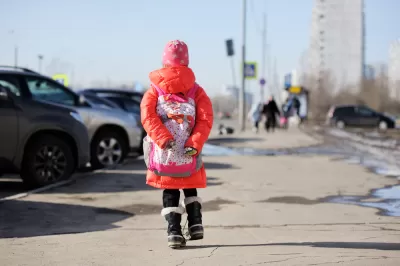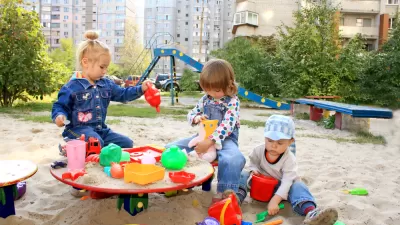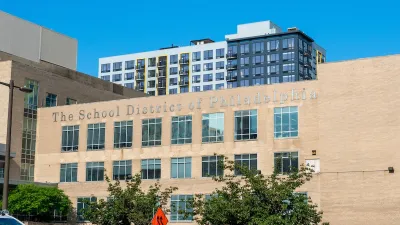A city that fosters the mental and physical health of children is safer for everyone. Six key planning and design considerations promote the well-being of the city's youngest residents.

We can use urban planning and design to better protect children. "It’s estimated that up to 500 children die daily in road crashes around the world; thousands more incur injuries and psychological trauma from collisions with vehicles that can affect them for years," write Nikita Luke, Rohit Tak, Ariadne Samios, and Claudia Adriazola-Steil.
Their article offers six ways cities can change the lives of kids for the better—ideas that go beyond adding playgrounds and aims to consider children's needs in decisionmaking processes regarding public policy.
The six improvements identified by the authors promote enhanced mental and physical health in young people: increase accessible green space, ensure safe pedestrian infrastructure, implement low-speed zones, include car-free streets, consider size, and create clean air zones.
But the benefits experienced by children would also be felt by adults. The article quotes Mayor Enrique Peñalosa of Bogotá in describing children as "a kind of indicator species." If urban planners and designers are able to build a city that promotes success for kids, everyone will experience success in cities.
"As cities and national governments reset after the coronavirus and ponder investments that will hasten a return to economic and social vibrance, incorporating the unique perspectives of children can help create more inclusive, healthier, livable cities. It’s time for cities to start thinking proactively and long-term about how best to serve all residents, including their youngest" write the authors.
FULL STORY: What Makes a Child-Friendly City? Redesigning Safer and Healthier Urban Spaces for Young People

Planetizen Federal Action Tracker
A weekly monitor of how Trump’s orders and actions are impacting planners and planning in America.

San Francisco's School District Spent $105M To Build Affordable Housing for Teachers — And That's Just the Beginning
SFUSD joins a growing list of school districts using their land holdings to address housing affordability challenges faced by their own employees.

The Tiny, Adorable $7,000 Car Turning Japan Onto EVs
The single seat Mibot charges from a regular plug as quickly as an iPad, and is about half the price of an average EV.

Seattle's Plan for Adopting Driverless Cars
Equity, safety, accessibility and affordability are front of mind as the city prepares for robotaxis and other autonomous vehicles.

As Trump Phases Out FEMA, Is It Time to Flee the Floodplains?
With less federal funding available for disaster relief efforts, the need to relocate at-risk communities is more urgent than ever.

With Protected Lanes, 460% More People Commute by Bike
For those needing more ammo, more data proving what we already knew is here.
Urban Design for Planners 1: Software Tools
This six-course series explores essential urban design concepts using open source software and equips planners with the tools they need to participate fully in the urban design process.
Planning for Universal Design
Learn the tools for implementing Universal Design in planning regulations.
Smith Gee Studio
City of Charlotte
City of Camden Redevelopment Agency
City of Astoria
Transportation Research & Education Center (TREC) at Portland State University
US High Speed Rail Association
City of Camden Redevelopment Agency
Municipality of Princeton (NJ)





























